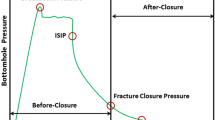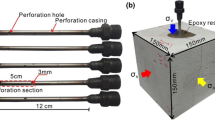Abstract
We present a novel technique for predicting dynamic fracture network response to production-driven changes in effective stress, with the potential for optimizing depletion planning and improving recovery prediction in stress-sensitive naturally fractured reservoirs. A key component of the method involves laboratory geomechanics testing of single fractures in order to develop a unique scaling relationship between fracture normal stiffness and initial mechanical aperture. Details of the workflow are as follows: tensile, opening mode fractures are created in a variety of low matrix permeability rocks with initial, unstressed apertures in the micrometer to millimeter range, as determined from image analyses of X-ray CT scans; subsequent hydrostatic compression of these fractured samples with synchronous radial strain and flow measurement indicates that both mechanical and hydraulic aperture reduction varies linearly with the natural logarithm of effective normal stress; these stress-sensitive single-fracture laboratory observations are then upscaled to networks with fracture populations displaying frequency-length and length-aperture scaling laws commonly exhibited by natural fracture arrays; functional relationships between reservoir pressure reduction and fracture network porosity, compressibility and directional permeabilities as generated by such discrete fracture network modeling are then exported to the reservoir simulator for improved naturally fractured reservoir performance prediction.














Similar content being viewed by others
References
Aguilera R (1999) Recovery factors and reserves in naturally fractured reservoirs. J Can Pet Technol 38:15–18
Aguilera R (2006) Effect of fracture compressibility on oil recovery from stress-sensitive naturally fractured reservoirs. J Can Pet Technol 45:49–59
Bandis S, Lumsden A, Barton N (1983) Fundamentals of rock joint deformation. Int J Rock Mech Min Sci 20:249–268
Barton N, Choubey V (1977) The shear strength of rock joints in theory and practice. Rock Mech 10:1–54
Barton N, Bandis S, Bakhtar K (1985) Strength, deformation and conductivity coupling of rock joints. Int J Rock Mech Min Sci 22:121–140
Barton C, Zoback M, Moos D (1995) Fluid flow along potentially active faults in crystalline rock. Geology 23:683–686
Beckner B, Hutfilz J, Ray M, Tomich J (2001) EMpower: new reservoir simulation system. In: SPE middle east oil show paper SPE-68116-MS, Bahrain, 17–20 Mar 2001
Brown S, Scholz C (1985) Closure of random elastic surfaces in contact. J Geophys Res 90:5531–5545
Chacon A, Tiab D (2007) Impact of pressure depletion on oil recovery in naturally fractured reservoirs. In: Latin American and Caribbean pet. eng. conference paper SPE 108107, Buenos Aires, 15–18 Apr 2007
Crawford B, Sanz P, Alramahi B, DeDontney N (2011) Modeling and prediction of formation compressibility and compactive pore collapse in siliciclastic reservoir rocks. In: 45th US rock mechanics symposium paper ARMA 11-384, San Francisco, 26–29 June 2011
Dershowitz W, LaPointe P, Eiben T, Wei L (2000) Integration of discrete fracture network methods with conventional simulator approaches. SPE Reserv Eval Eng 3:165–170
Dudley J, Brignoli M, Crawford B, Ewy R, Love D, McLennan J, Ramos G, Shafer J, Sharf-Aldin M, Siebrits E, Boyer J, Chertov M (2016) ISRM suggested method for uniaxial-strain compressibility testing for reservoir geomechanics. Rock Mech Rock Eng 49:4153–4178. doi:10.1007/s00603-016-1055-4
Engelder T, Scholz C (1981) Fluid flow along very smooth joints at effective pressures up to 200 megapascals. In: Carter N (ed) Mechanical behavior of crustal rocks, Geophys. monogr., vol 24, pp 147–152
Ewy R, Bovberg C, Hagin P, Shalz M (2012) Permeability measurement with ultra-high fluid pressure and unequal stresses. In: 46th US rock mechanics/geomechanics symposium paper ARMA 12-656, Chicago, 24–27 June 2012
Gillespie P, Walsh J, Watterson J, Bonson C, Manzocchi T (2001) Scaling relationships of joint and vein arrays from the Burren, Co. Clare, Ireland. J Struct Geol 23:183–201
Giraldo L, Chen H, Teufel L (2000) Field case study of geomechanical impact of pressure depletion in the low permeability Cupiagua gas condensate reservoir. In: Rocky mountain regional/low permeability reservoirs symposium paper SPE 60297, Denver, 12–15 Mar 2000
Goodman R (1976) Methods of geological engineering in discontinuous rocks. West Publishing, New York
Guenther K, Perkins S, Dale B, Pakal R, Wylie P (2005) South Diana, Gulf of Mexico, USA: a case study in reservoir management of a compacting gas reservoir. In: International petroleum technology conference paper 10900-MS IPTC, Doha, 21–23 Nov 2005
Hall H (1953) Compressibility of reservoir rocks. Trans Am Inst Mech Eng 98:309–311
Jaeger J, Cook N, Zimmerman R (2007) Fundamentals of rock mechanics. Blackwell, Oxford
Klimczak C, Schultz R, Parashar R, Reeves D (2010) Cubic law with aperture-length correlation: implications for network scale fluid flow. Hydrogeol J. doi:10.1007/s10040-009-0572-6
Kranz R, Frankel A, Engelder T, Scholz C (1979) The permeability of whole and jointed Barre granite. Int J Rock Mech Min Sci 16:225–234
Kranz R, Frankel A, Engelder T, Scholz C (1980) Erratum. Corrections to the paper the permeability of whole and jointed Barre granite. Int J Rock Mech Min Sci 17:237–238
Lorenz J, Warpinski N, Teufel L (1996) Natural fracture characteristics and effects. The leading edge, August, 909–911
Myers R, Crawford B, Barron J, Huang H (2017) Predicting stress sensitive productivity of naturally fractured reservoirs in low strain environments. In: Middle east oil and gas show and conference paper SPE 183926, Manama, 6–9 Mar 2017
Nelson R, Handin J (1977) Experimental study of fracture permeability in porous rock. AAPG Bull 61:227–236
Oda M (1985) Permeability tensor for discontinuous rock masses. Géotechnique 35:483–495
Pourciau R, Fisk J, Descant F, Waltman R (2005) Completion and well-performance results, genesis field, deepwater Gulf of Mexico. SPE Drill Complet 20:147–155
Putra E, Schechter D (1999) Reservoir simulation of waterflood pilot in naturally fractured Spraberry trend. In: Asia Pacific oil and gas conference and exhibition paper SPE 54336, Jakarta, 20–22 Apr 1999
Rossen R, Shen E (1989) Simulation of gas/oil drainage and water/oil imbibition in naturally fractured reservoirs. SPE Reserv Eng 4:464–470. doi:10.2118/16982-PA
Shchipanov A, Kollbotn L, Surguchev L, Thomas K (2010) A new approach to deformable fractured reservoir characterization: case study of the Ekofisk field. In: EUROPEC/EAGE annual conference and exhibition paper SPE 130425, Barcelona, 14–17 June 2010
Stearns D, Friedman M (1972) Reservoirs in fractured rock. In: King R (ed) Stratigraphic oil and gas fields: classification, exploration methods and case studies, AAPG memoir, vol 16, pp 82–106
Tsenn MC (2015) Permeability of partially cemented fractures. In: Faybishenko B, Benson SM, Gale JE (eds) Fluid dynamics in complex fractured-porous systems. Wiley, Hoboken, NJ. doi:10.1002/9781118877517.ch8
Vega Navarro O (2012) Closure of natural fractures caused by increased effective stress, a case study: reservoir Robore III, Bulo Bulo field, Bolivia. In: Latin American and Caribbean pet. eng. conference paper SPE 153609, Mexico City, 16–18 Apr 2012
Zangerl C, Evans K, Eberhardt E, Loew S (2008) Normal stiffness of fractures in granitic rock: a compilation of laboratory and in situ experiments. Int J Rock Mech Min Sci 45:1500–1507
Zimmerman R, Bodvarsson G (1996) Hydraulic conductivity of rock fractures. Transp Porous Media 23:1–30
Acknowledgements
We thank the management of ExxonMobil Upstream Research Company for permission to publish this study.
Author information
Authors and Affiliations
Corresponding author
Additional information
M. C. Tsenn: Retired from ExxonMobil Upstream Research Company, Spring, TX, USA.
Rights and permissions
About this article
Cite this article
Crawford, B.R., Tsenn, M.C., Homburg, J.M. et al. Incorporating Scale-Dependent Fracture Stiffness for Improved Reservoir Performance Prediction. Rock Mech Rock Eng 50, 3349–3359 (2017). https://doi.org/10.1007/s00603-017-1314-z
Received:
Accepted:
Published:
Issue Date:
DOI: https://doi.org/10.1007/s00603-017-1314-z




